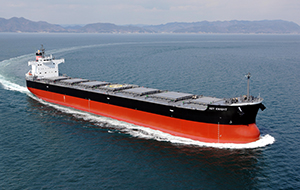NIPPON YUKA KOGYO >> Cleaning Agent
Most of the while scales found on vessels can be classified into the following 3 types, and we offer the dissolution agent for each type.
Main component of scale |
Usually found on |
Compatible product |
Main component of product |
Calcium carbonate
|
Seawater side of air coolers
|
Yunisol X
|
Hydrochloric acid
|
Calcium sulfate CaSO4 |
Seawater side of evaporators |
Yunisol EV II
|
Chelating agent
|
Silica & CaCO3 mixture |
Systems using groundwater |
Yunisol X
|
Hydrochloric acid |


Difference between oil, sludge and hard carbon "Black stains" found on vessels are mainly from fuel oil and lubricating oil. These oils are originally liquid but with the evaporation of light components caused by heating, they turn into "sludge" with an extremely high viscosity. As carbonization further progresses, they change into "hard carbon".
Oil based cleaning agent can remove oil stains because oil can dissolve oil. But when oil turns into sludge, it can only be dissolved by solvents with a higher solubility, and when it changes into hard carbon, it will completely lose the properties of oil and is rather soluble in alkaline water.
Type of stain |
Compatible Yunisol |
Fuel Oil and Lubricating Oil |
Yunisol C |
Sludge |
Yunisol H |
Hard Carbon |
Hi-CARBON (for Aluminium) |
There are different types of oil stains: tough ones such as sludge which is the residue of oil with its light components evaporated, fuel oil exuded on the paint, and stains like lubricant oils that can be wiped by a cloth. Taking into account the price of detergents and environmental impact, it is better to use water based detergents as much as possible and only use oil based detergents for stains that cannot be removed by water based ones.

Dirt on air-side fins
 Dirt attached on air-side fins of air coolers are a mix of carbonaceous particles such as soot and oil mist of unburned fuel components.
Dirt attached on air-side fins of air coolers are a mix of carbonaceous particles such as soot and oil mist of unburned fuel components.
Carbonaceous particles can be removed by alkaline cleaners and oil mist can be removed by oil based cleaners. However, it is very difficult to remove the mix of these substances. If you use an alkaline cleaner, oil will repel the water based alkaline cleaner; if you use oil based cleaner, carbonaceous particles will get in the way and stop oil from being removed.
Yunisol AC and SH are cleaners designed to remove both carbonaceous and oil simultaneously. An effective cleaning method is to immerse one side to remove the loose stains first, and then immerse the other side. This method can efficiently remove dirt and prevent swollen dirt peeled from fins from blocking the spaces between fins.
Dirt in tubes of seawater side
We analyzed the white scales attached on the seawater side of air coolers of many vessels. We found that in most cases, the main component of the scales is calcium carbonate and there is also a small amount of calcium sulfate. Therefore in most cases, if you dissolve the calcium carbonate the scales will be removed.
However, if the amount of scales is large enough to block the tube, the cylindrical scale will usually have calcium carbonate on the outside (the side that is in contact with tube) and calcium sulfate in the center (part that seawater passes through). Calcium sulfate is easier to be formed when the temperature goes higher.

When the amount of scales increases, the contact area of scale and cleaner is very small and a longer time of dissolution is required. Calcium sulfate cannot be dissolved by an acid cleaner.
Yunisol X is a powerful dissolving agent of calcium carbonate. Therefore, it is better to use Yunisol X to do circulating cleaning at an early stage before the scales build up and block the tube, or regular cleaning is recommended as well. It is impossible to do a circulating cleaning when the tube is completely blocked.
Type and proper use of rust removal agent
There are different types of rust removal agents including acidic and alkaline ones, but generally they are acidic. The main components are inorganic acid (phosphoric acid, hydrochloric acid, etc.) and organic acids (malic acid, oxalic acid) for acidic ones, and thioglycolic acid salt for neutral ones. They are used according to the type of rust, location (base material) and extent.
Yunisol P (not suitable for light metal)
A rust removing agent mainly composed of phosphoric acid. There are 2 effects when using phosphoric acid to remove rust: first, the iron rust can be removed and second, the dissolved iron compounds with phosphoric acid so that iron phosphate is formed, which acts as a dense "phosphate coating" on the surface of the metal to prevent rust.
Please use it to remove the flow rust on paint surface.
Yunisol X (not suitable for light metal)
An acidic cleaning agent mainly composed of hydrochloric acid and inhibitor (metal corrosion inhibitor). It is ideal for removing deep rust on a large surface of iron board, because hydrochloric acid (main component of Yunisol X) has a higher ability to dissolve iron rust than phosphoric acid (main component of Yunisol P).
However, it may affect the base material depending on the condition of use. It cannot form an anti-rust coating like Yunisol P, so some kind of anti-rust treatment is needed after washing.
Feel free to contact us if you are interested with cleaning agents.